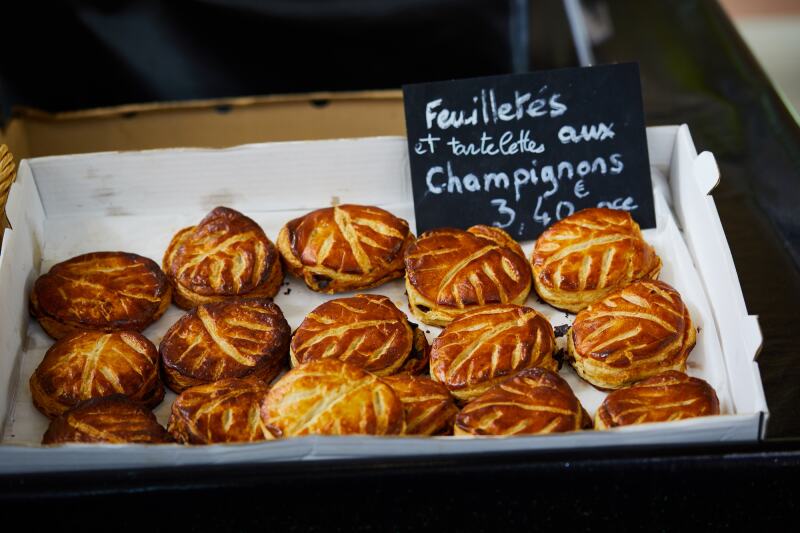Dijon, France, is among a handful of international locales with an eponymous culinary export that’s more famous than the town itself, much like the rolling agave hills of Tequila, Mexico, the olive groves of Kalamata, Greece, and the pastoral dairy farms of Parma, Italy. But this charming French city is worth visiting for much more than a taste of the spicy sandwich staple that’s named after it. Thanks to its well-preserved historic architecture, updated museums and hotels, world-class shopping and restaurants, and a vineyard-laden countryside, Dijon should be a stop on any traveler’s tour of France’s famous Burgundy region.

The French mustard brand La Maison Maille helped land Dijon on the world’s mustard-making map.
Photo by Remko Kraaijeveld
What to do
Dijon’s mustard is famous for a reason, so sampling its signature spread is a great place to kick off your journey. Begin at La Maison Maille on Rue de la Liberté, a can’t-miss corner boutique from the French company that landed the city on the mustard map back in the mid-1700s. Inside the apothecary-style shop, you’ll find hundreds of earthenware pots brimming with unique mustards (tip: go for the white truffle-parmesan) along with fascinating displays detailing Maille’s long history and production process. Once you’ve finished perusing, make sure to pick up a jar or two to bring back home—in France, Maille’s mustard is made with white wine while the glass jarred version found in U.S. grocery stores uses vinegar, resulting in a less complex taste and aroma.
Next, immerse yourself in Dijon’s captivating artistic landscape at the Musée des Beaux Arts, which reopened in 2019 after a massive $66 million renovation that took almost 10 years to complete. Set in the stunning 14th-century Palais des Ducs, the fine art museum includes highlights such as the intricately carved 15th-century tombs of Dukes Philip the Bold and John the Fearless, Burgundian art dating to the Middle Ages, and an engrossing Egyptian collection, all housed in the opulent Salle des Gardes. And no visit to Dijon would be complete without tracking down the lucky stone owl perched on the north side of the towering Église Notre Dame: Follow the Parcours de la Chouette (the Owl Walk), a designated trail connecting 22 inlaid bronze triangles emblazoned with the image of an owl, through the city center until you reach the wish-granting totem.

Les Halles is one of France’s best-known markets, coming to life every Tuesday, Thursday, Friday, and Saturday with an incredible selection of meats, candies, cheeses, fruits, vegetables, and ready-to-eat pastries.
Photo by Remko Kraaijeveld
France is known for its bustling year-round markets, and Dijon claims one of the country’s very best. Wander the Les Halles market to soak up the sights, sounds, and smells that emanate from the stalls crowded inside. Bring a basket and complement your mustard collection with picnic-perfect accompaniments such as aged cheeses, freshly harvested truffles, and thick slabs of jambon persillé, a charcuterie specialty that consists of cubed ham and fragrant parsley suspended in a wine-based gelatin mold. Further shopping can be found nearby along the Rue Verrerie, a pedestrian street lined with antiques dealers, art galleries, and design shops that peddle one-of-a-kind finds out of historic half-timbered houses.
Where to eat and drink
Choice cocktails, wine, and award-winning meals are never far from reach in Dijon, which gained a new Michelin star in 2019 with L’Aspérule, a set-menu restaurant helmed by Joël Robuchon protégé Keigo Kimura, who serves French cuisine with a Japanese twist. This establishment brought the city’s grand total to five Michelin-starred restaurants, including the two-starred William Frachot, plus seven restaurants that earned Michelin’s Bib Gourmand nod for exceptional food at moderate prices.
Treat yourself to exquisite French cuisine (not to mention a glorious four-tiered cheese cart) at Loiseau des Ducs, Dominique Loiseau’s ode to her late husband chef Bernard Loiseau, which is housed inside the 16th-century Hôtel de Talmay. To keep it casual, head to Chez Copains or Bistrot des Halles, two of the many family-run bistros clustered around the city center.

Dijon’s namesake mustard is made by replacing the condiment’s usual ingredient of vinegar with white wine or verjuice, the acidic juice of unripe grapes, which grow in the French winemaking region.
Photo by Remko Kraaijeveld
Spend an afternoon sipping your way through Burgundy’s top vintages by hiring a car or renting a bicycle to ride down the Route des Grand Crus, a nearly 40-mile stretch from Dijon to neighboring Beaune; it weaves through mustard fields to the area’s top wineries. Stop off at the 12th-century Château du Clos de Vougeot in Côte d’Or, headquarters of the wine-loving Confrérie des Chevaliers du Tastevin bacchanalian fraternity, for a hands-on crash-course in Burgundian viticulture. In town, the expertly stocked Dr. Wine has your vino needs covered, and try Monsieur Moutarde, a friendly, spacious cocktail bar shaking up creative tipples alongside finger foods and an impressive spirits list.
The culinary excitement doesn’t end there: Keep your eyes peeled for the unveiling of International City of Gastronomy, a highly anticipated 16-acre dining, entertainment, and residential complex dedicated to regional food and drink in Dijon slated for completion by 2021.
Where to stay
A tourist-friendly town to its core, Dijon boasts several outstanding places to lay your head. The boutique Hotel Vertigo, with its quirky, modern guest rooms, sleek cocktail bar, and spa, is a natural choice for design lovers, while the Maison Philippe Le Bon, a network of three updated mansions surrounding a Gothic courtyard, is a historic delight. Additionally, the five-star Grand Hotel La Cloche, a palatial, illuminated expanse overlooking the Place Darcy, has served as the city’s premiere luxury retreat since opening its doors 1884.
>>Next: Plan Your Trip With AFAR’s Guide to France











